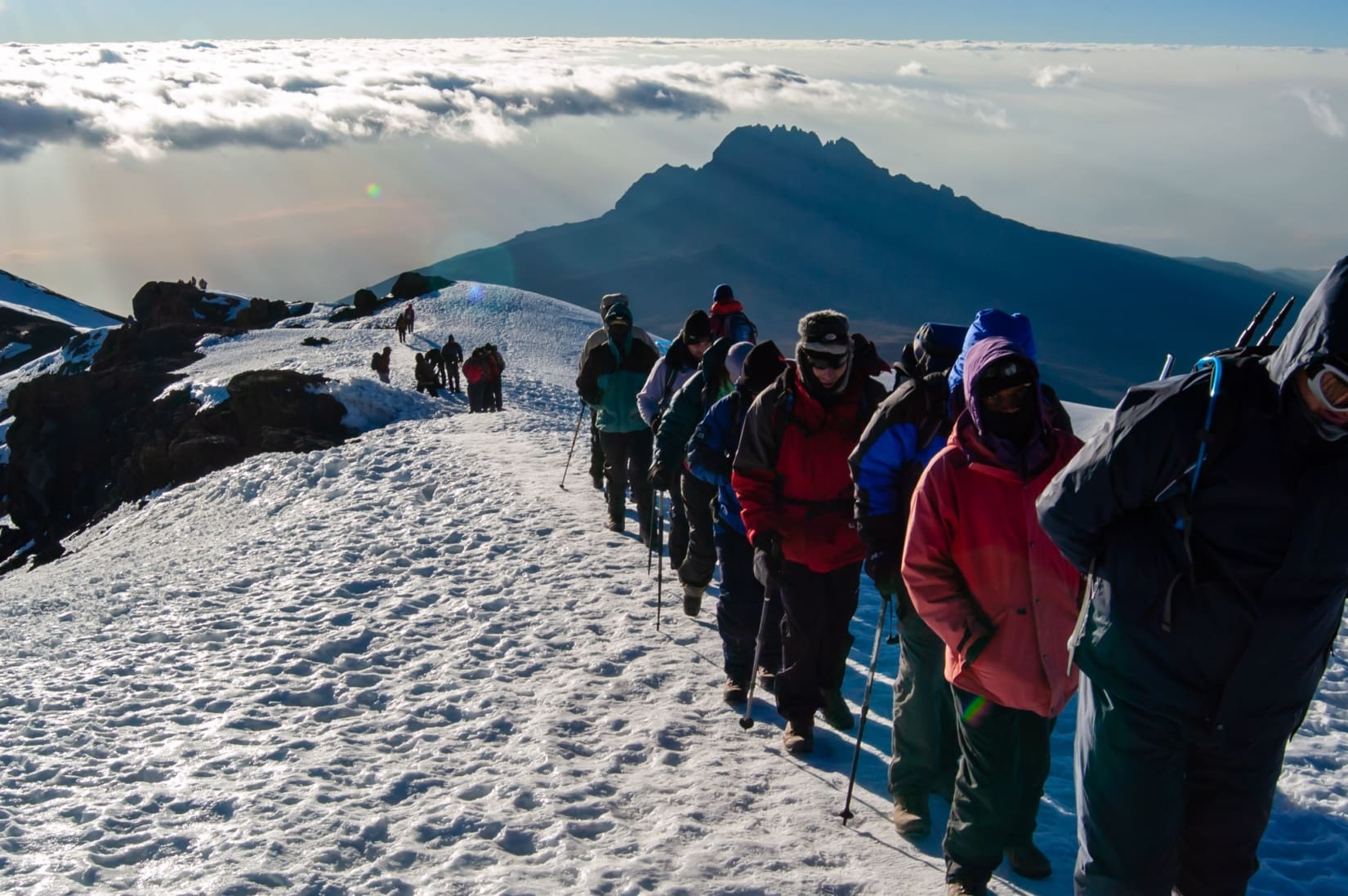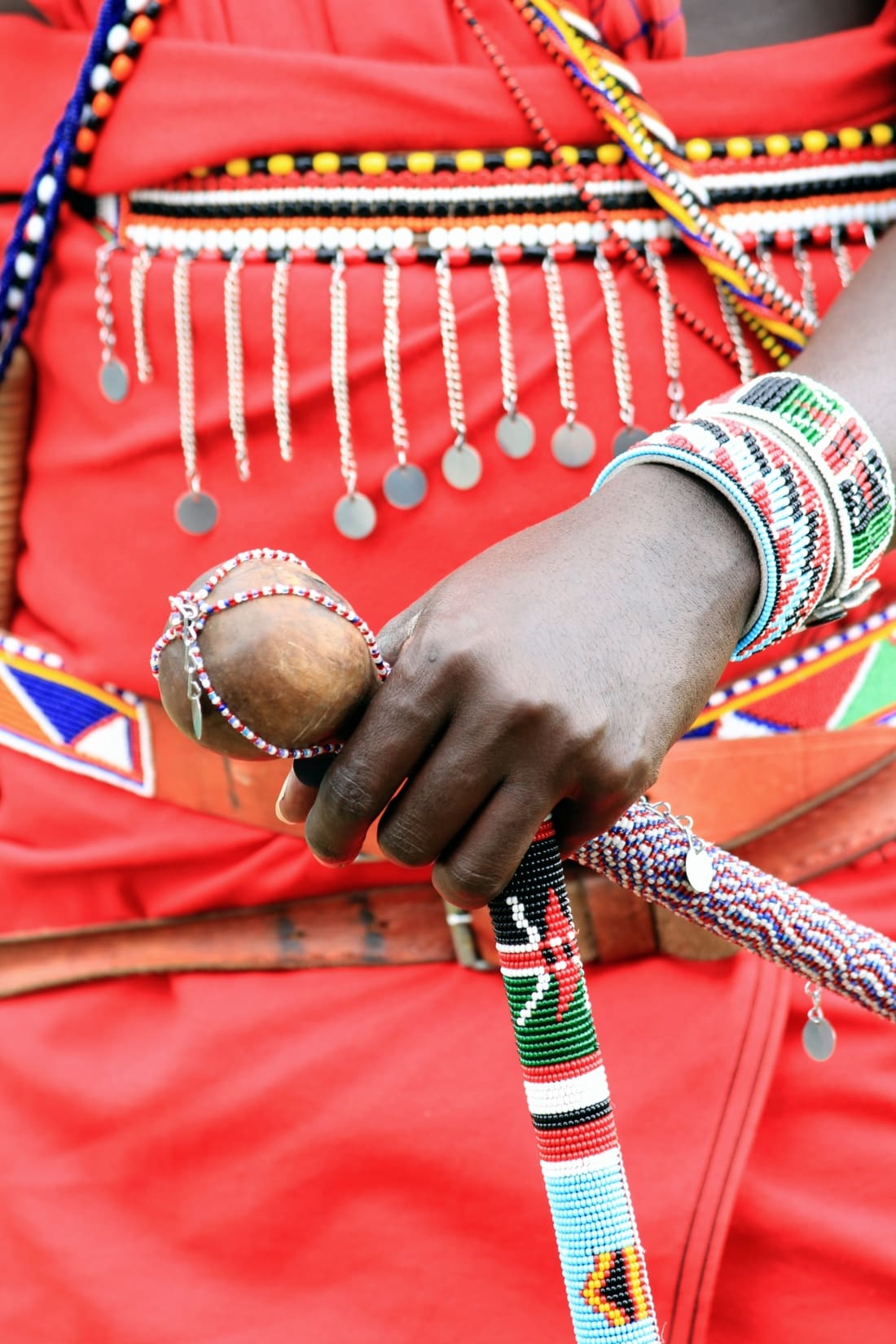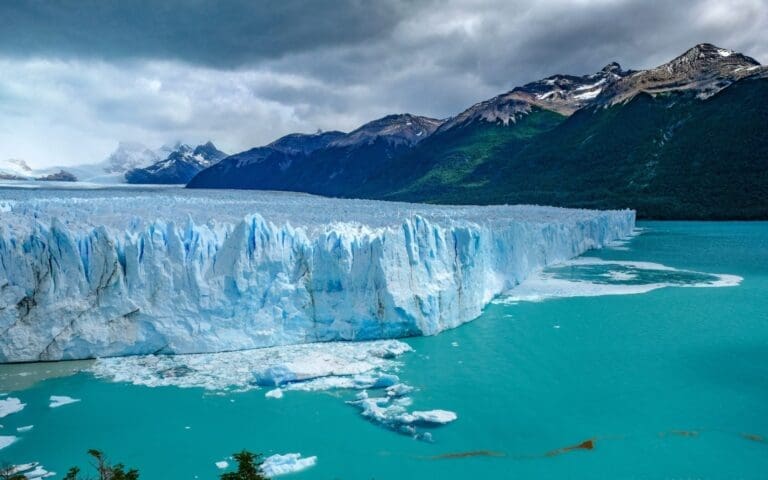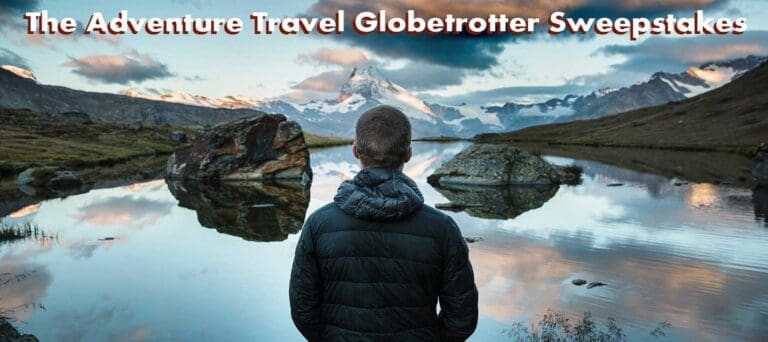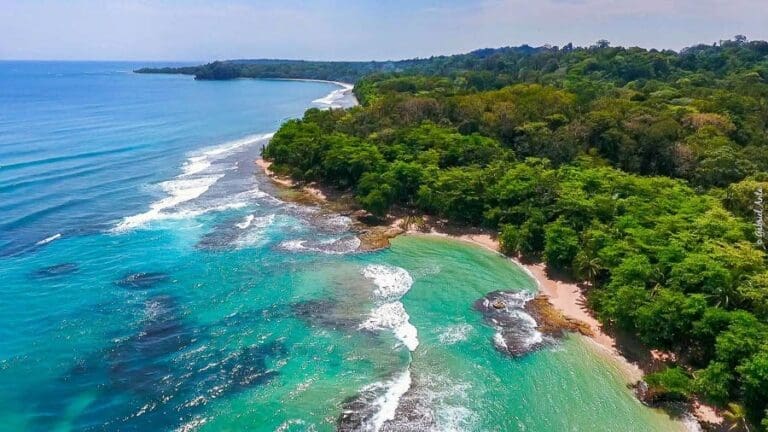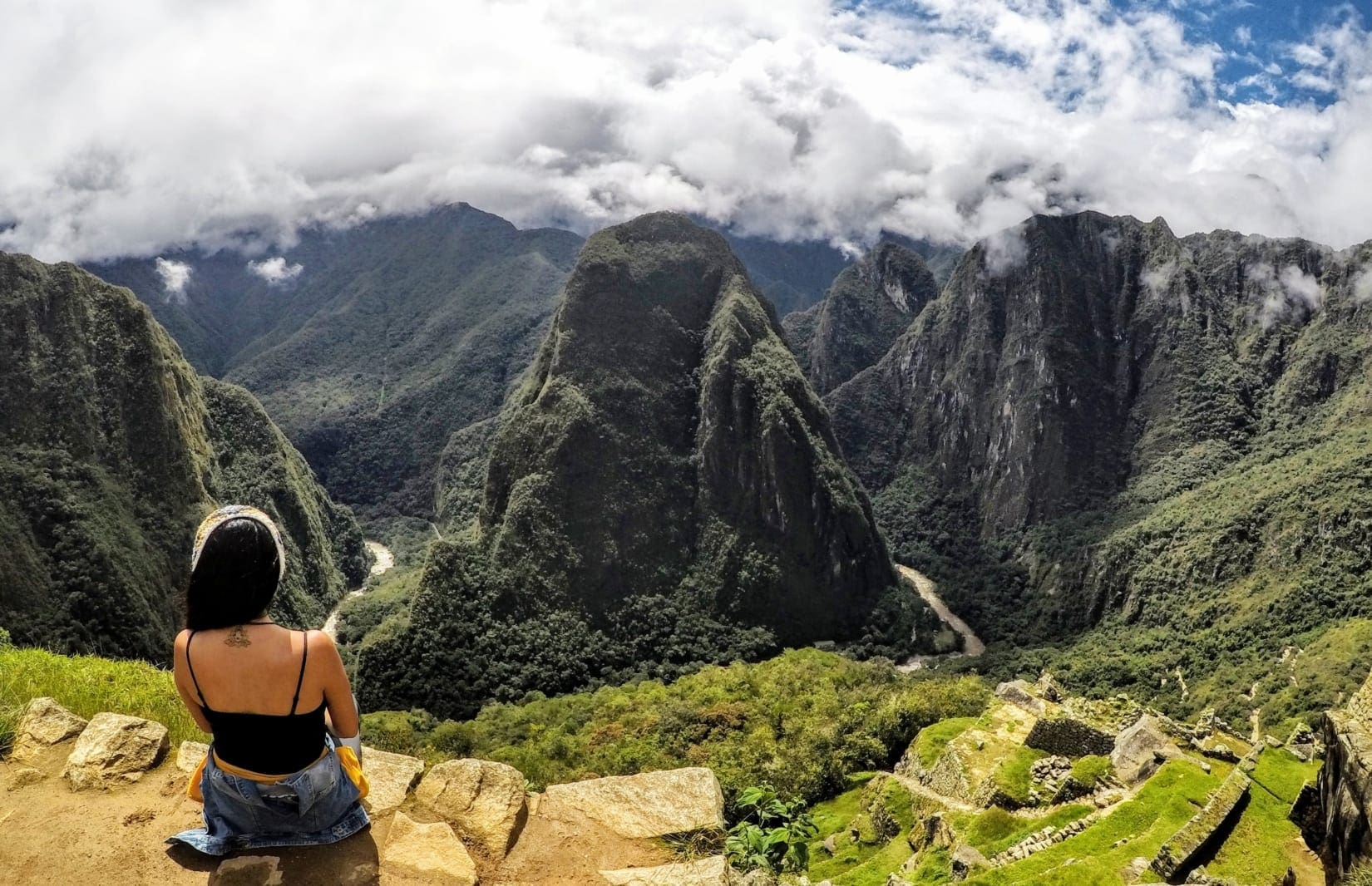The Ultimate Guide to Climbing Mount Kilimanjaro
Mount Kilimanjaro is the fabled Roof of Africa. Climbing Mount Kilimanjaro demands determination, dedication, and energy. But it’s also a summit that rewards with visions of African ice caps, wanderings through moss-caked cloud forests, encounters with elephants, and – of course – a chance to stand at the highest point on the continent. Soaring 19,341 feet (5,895 meters) above sea level in the midst of northern Tanzania, it crashes through the clouds to a trio of volcanic cones that were formed millions of years ago.
You’ve stumbled across this post because you’re interested in Africa’s highest mountain. Mount Kilimanjaro is one of the most popular destinations for trekkers around the world. In this ultimate travel guide, you’ll discover expert information to help prepare you for one of the best climbing adventures of your life!
What’s in this Guide?
- My experience on Mount Kilimanjaro
- About Mount Kilimanjaro
- History of climbing Mount Kilimanjaro
- Getting to Mount Kilimanjaro
- An overview of Moshi, Tanzania
- When is the best time to climb Mount Kilimanjaro?
- Mount Kilimanjaro climbing routes
- Sample itinerary of Kilimanjaro’s most popular route
- Key sites while climbing Kilimanjaro
- Preparation and training
- Other adventures near Mount Kilimanjaro
1. My experience on Mount Kilimanjaro
Mount Kilimanjaro is a trek that asks a lot but gives a huge payoff. Seven days of climbing this sleeping giant from the farms around Moshi, Tanzania to the scree-rimmed summit took me through some of the most incredible landscapes I’ve ever encountered.

From my perspective, things looked bare from afar, but then I was greeted by groves of spider-like ferns and mkulo trees on the lower slopes that gave way to gnarled junipers and heathlands higher up. As I approached the trailhead, I saw elephants, Cape buffalo, and even leopards. From the saddle to the summit itself, where I spent (and you will too) the bulk of the trek, it’s like being on the Moon. Petrified volcanic stone speckles the plains there, and only hardy tufts of grass poke through.
I opted for the common and wildly popular Machame Route. It’s got the highest success rate of all the seven routes up Kilimanjaro and peppers the journey with welcome acclimatization camps. My summit push happened on day six of seven. It was the true highlight of the Mount Kilimanjaro hike, opening vistas that sweep north into the elephant-stalked savannahs of Kenya and across to mystical Mount Meru deeper into Tanzania. I’ll never forget that view and you must see it for yourself!
2. About Mount Kilimanjaro
Mount Kilimanjaro is the highest mountain in Africa, located in Tanzania. It clocks up an altitude of 19,341 feet (5,895 meters) and anchors the amazing Kilimanjaro National Park in the far north of Tanzania. It’s actually a dormant volcano that’s formed of three main cones. They sit almost equidistant apart, running from Shira (the lowest) in the east to Mawenzi in the west. Hikers are usually aiming for Kibo, the middle cone. That’s where Uhuru Peak, the pinnacle of Kilimanjaro and the final goal of most treks, shoulders above the crater on a bluff.
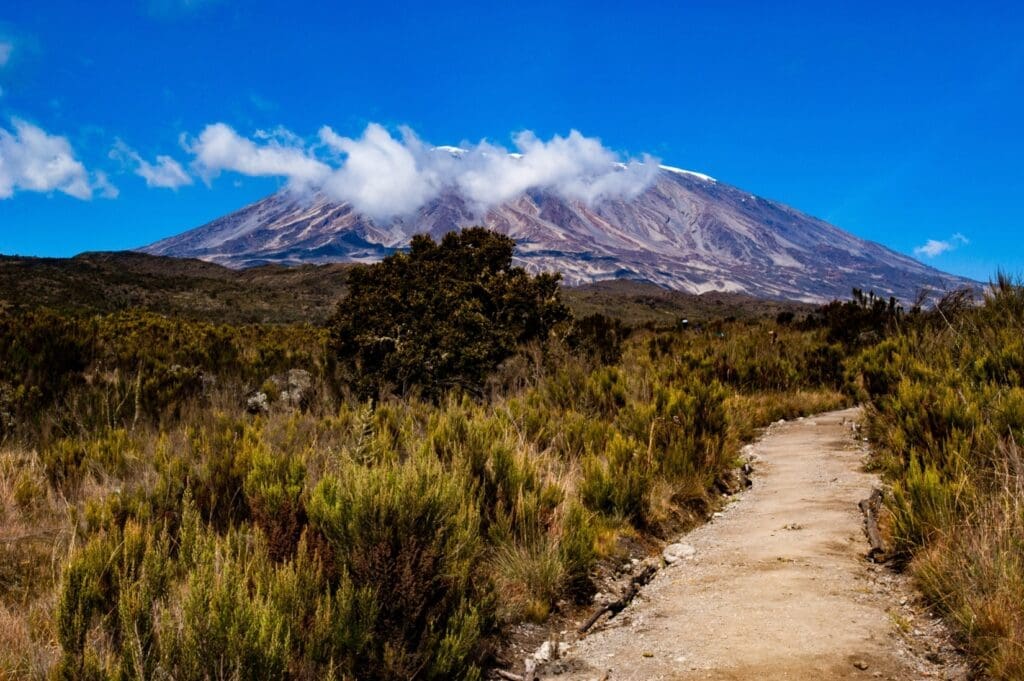
Kilimanjaro is a mountain of two sides. The northern slopes are softer and host way less vegetation. They drop away towards the Tanzania-Kenya border in sinews of lava chutes and dusty scree. The south is encircled by a lush ring of montane forest and cloud forest, and the main peaks of Uhuru and Mawenzi loom steeper overhead.
One of the defining features of Kilimanjaro is what’s known as the Saddle Plateau. It’s where the mountain sort of flattens out at around 14,400 feet (4,400 meters), forming a tabletop region between the smaller craters with Kibo right in the middle. Good news for trekkers, it gives ample space for multiple acclimatization camps – the whole Saddle measures close to 14.9 miles (24 kilometers) from end to end! Still interested in learning more? Check out these 10 Fast Facts About Mount Kilimanjaro.
3. History of climbing Mount Kilimanjaro
The volcanic activity that formed the cloud-shattering tops of Mount Kilimanjaro is thought to have started around a million years ago and lasted something in the region of 500,000 years. It gave rise to a hulking mass of a peak that has itself inspired human legends. The Tanzania region’s Swahili Chagga people tell of ancient elephant burial grounds on the summit. Others have posited it as the potential source of the life-giving River Nile.
Recorded attempts to climb Kilimanjaro didn’t begin in earnest until the Germans came to East Africa in the second half of the 19th century. Hans Meyer and his Austrian climbing partner Ludwig Purtscheller are now hailed as the first Europeans to conquer the top of Kibo crater and complete the Kilimanjaro hike, which they finally managed in 1889 after a former failed attempt. They did it with help from a team of Swahili porters and camp builders. If this rich history excites you, check out our other Five Top Adventure Destinations for History Buffs!
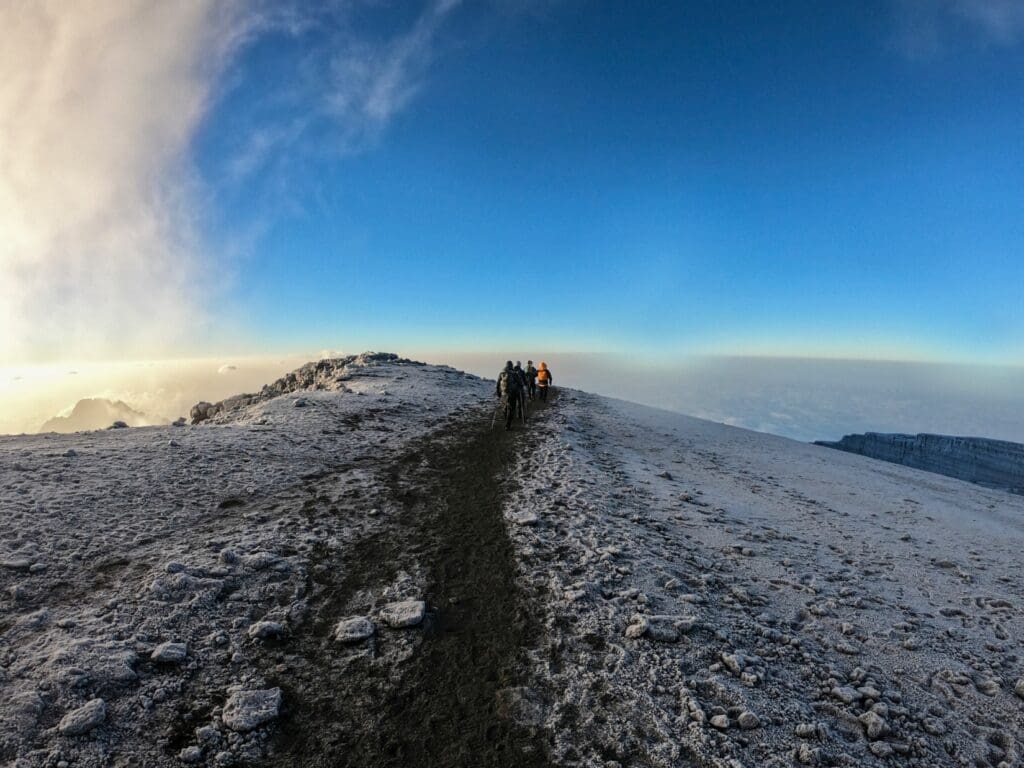
Since then, the allure of the mythic Roof of Africa and the journey to climb Kilimanjaro has only grown and grown. Today, the mountain sustains a whole industry of climbers and climb assistants in Tanzania – one estimation is that it supports up to 11,000 jobs in the region. A whopping 35,000 to 50,000 trekkers are thought to attempt the Mount Kilimanjaro climb each year, with just over two-thirds of them making it to the summit and successfully completing the Kilimanjaro hike.
4. Getting to Mount Kilimanjaro
There’s no better way to get right into the base of the great mountain than with a flight to the Kilimanjaro International Airport where your quest to climb Kilimanjaro begins. It’s not only the gateway to the trailheads for Africa’s highest peak, though. It’s also one of the prime access points for the safari meccas of Arusha National Park, the Ngorongoro Crater, and the savannahs of Tarangire National Park. That means there will be high competition for airfare, so don’t hang around when you come to book.
Thankfully, there’s a good mix of long-haul carriers coming in from Middle Eastern hubs like Istanbul and Doha, along with big European changeover points like Amsterdam Schiphol. There are also plenty of arrivals from African destinations, including Nairobi, Dar es Salaam, and Entebbe.
From the Kilimanjaro International Airport, look to get to Moshi, Tanzania. There’s a good chance that the pickup and transfer will be included in your trekking package. If not, a private taxi from the terminals to any hotel in the town is set at a fixed rate of $50. There are also shared shuttle buses run by Precision Air that cost closer to $5 a head.
All prices listed in US Dollars.
5. An overview of Moshi, Tanzania
Moshi is known as the loveable, ramshackle hub of the whole Kilimanjaro region. A cacophony of honking 4X4s and crying goat herds, it’s the launchpad for the vast majority of expeditions to climb Kilimanjaro. During peak climbing season (more on that below), you can hardly move for trekkers – some fresh-faced and raring to go, others tanned and tired but with one line less on the bucket list– completing the Kilimanjaro hike to the summit.
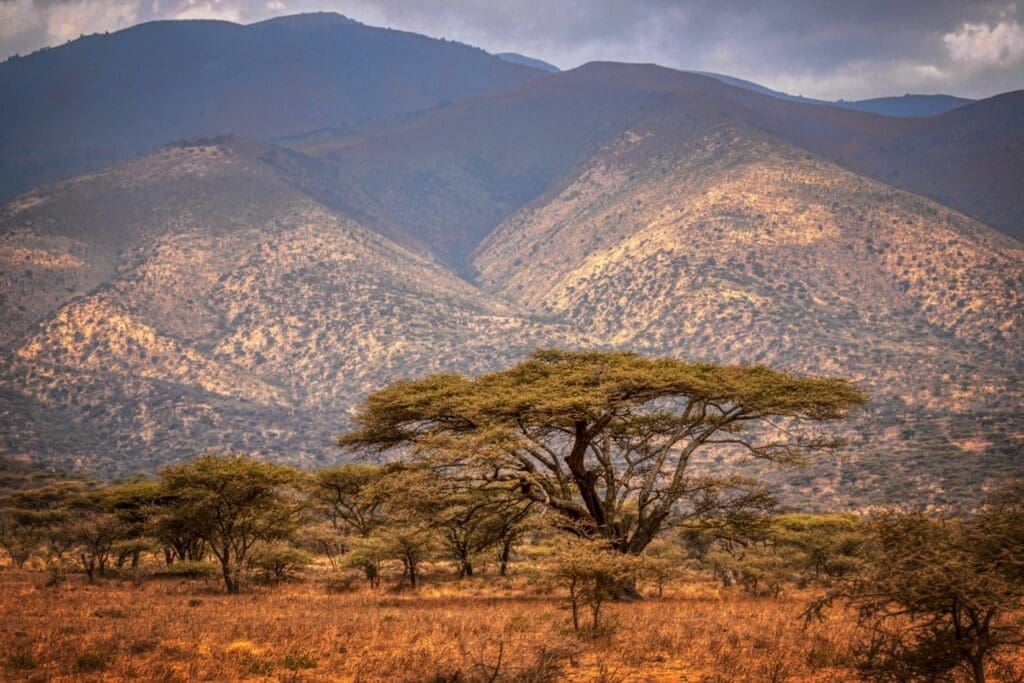
Don’t whiz out of Moshi for the trailheads too quickly. Take some time to delve into the frenetic Chagga Street bazaar or navigate the stalls of the Mbuyuni market down Double Road, taking in all that Tanzania has to offer. They are working trading places where you can buy everything from used hiking gear to unusual healing roots from Maasai medicine men (not recommended!).
Moshi also has a fine gastronomic offering to help you fuel up before the Kilimanjaro hike or rejuvenate after returning from the summit. That comes in the form of Indian cookhouses selling spicy curries from across the Arabian Sea, a few Italian kitchens, and plenty of coffee stops – you’re in one of Tanzania’s top bean-growing regions, remember?
If you’re doing an organized tour and you haven’t already joined your trekking group at the airport, then you’re likely to do it in Moshi. It’s where you’ll leave from on the first day, usually to the starting point of the Machame Route, which is roughly a 30- to 40-minute drive to the northwest of town.
6. When is the best time to climb Mount Kilimanjaro?
So you want to climb Mount Kilimanjaro when the time is best. The general rule for climbing Mount Kilimanjaro is to dodge the wet seasons. Tanzania has two of those: the short monsoon season and the long monsoon season. The first – just as the name implies – is over pretty quick. It lasts from the start of November to the first or second week of December. The second spans about three months, from March until May. That really leaves two windows of opportunity for trekkers who want what I’d consider to be peak conditions for their Mount Kilimanjaro hike:
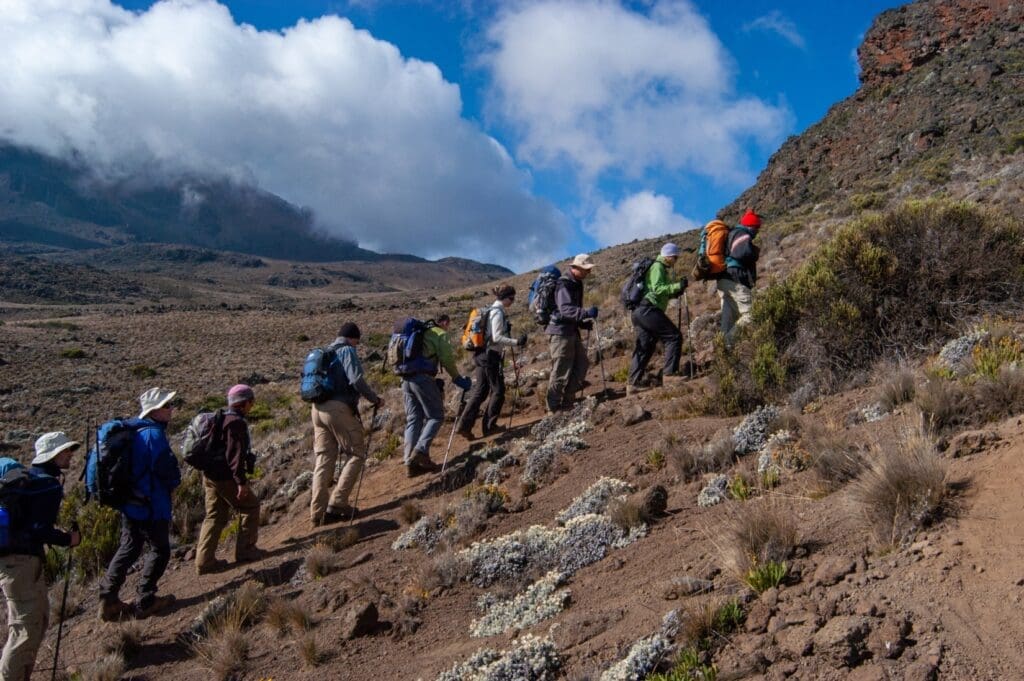
You don’t necessarily have to stick to the above seasons to make climbing Kilimanjaro a success. It’s actually possible to climb Mount Kilimanjaro at any time in the year. It’s just that the monsoons bring unpredictability into the mix and that means there’s less of a chance that your Kilimanjaro hike will be a success. More practically, traveling during the rainy season means contending with heavy downpours and muddy trails, so you’ll need to pack accordingly.
Keep in mind that the weather can vary quite a bit depending on the route you choose. Higher routes, like the Machame, tend to get colder faster as you ascend, while lower routes, such as the Rongai, generally experience milder temperatures. No matter when you go, it’s essential to be prepared for temperature swings – even in the warmest months, the summit can hit sub-zero temperatures, so layering is key!
7. Mount Kilimanjaro climbing routes
How long does it take to climb Mount Kilimanjaro? Depending on your choice of climbing route, the trek takes between five to seven nights from base to summit. Choosing the right climbing route is arguably the single most important part of planning to climb Mount Kilimanjaro. There are seven routes up Kilimanjaro and each promises a unique experience of the mountain and varying cost to climb. These include the Machame, Marangu, Shira, Lemosho, Umbwe, Rongai, and the Northern Circuit routes.
One might be a slow slog to the summit over seven nights. Another could be a quick five-day romp from base to summit that requires pre-acclimatization and plenty of training to climb Kili on this route. Each trek crosses a different part of the peak on the way to the summit, so you’ll see different things as you climb Kili – cloud forest, montane jungle, scree – depending on which you choose. However, most converge on the upper Saddle Plateau where you prep for the final push to Uhuru Peak.

Here’s a closer look at each of the seven routes up Kilimanjaro:
You should also be aware of the Mweka Route of climbing Kilimanjaro. It’s reserved for descents of the mountain on the south side and has a single camp pitstop on the way. It finishes at the Mweka Gate, which is only a 35-minute transfer back to Moshi. Can’t decide which route is best for you? Contact my team at The Explorer’s Passage, the premier adventure tour company on the planet, for a free travel consultation to help you find the best fit for your Kilimanjaro hike!
8. Sample daily itinerary of the popular Machame Route
As we’ve already mentioned, the Machame Route is now by far the most popular way to scale Kilimanjaro and it’s easy to see why.
First off, it offers what we think is the most diverse array of scenery of any trekking path here, first in the lush jungles on the southwestern side of the peak and then along the lunar-like Shira Plateau.
Secondly, it’s been designed to fit with best practices in acclimatization, allowing trekkers to climb high and sleep low. It’s not for nothing that it has an 85% success rate – the best of all the paths on the mountain.
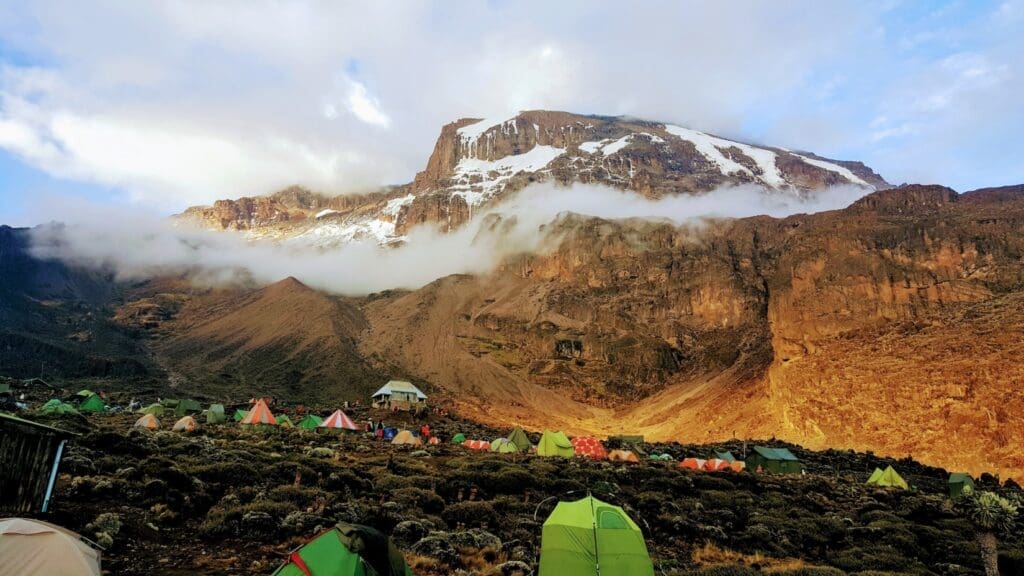
The Machame Route is one of the routes we offer on our very own Kilimanjaro expeditions. So, here’s a closer look at what to expect each day, from the moment you arrive in Moshi to the last descent through the Mweka Gate and your departure from Tanzania:
9. Key sites while climbing Kilimanjaro
Climbing Mount Kilimanjaro isn’t about checking off the sights like you do on a city break. It’s about moving through primeval cloud forests and jungles to scree ridges carved and blasted by ancient volcanic eruptions. It’s about scaling ridges above the clouds to survey plains dotted with elephants that look no bigger than ants below. To put it another way: Climbing Mount Kilimanjaro is about the journey.
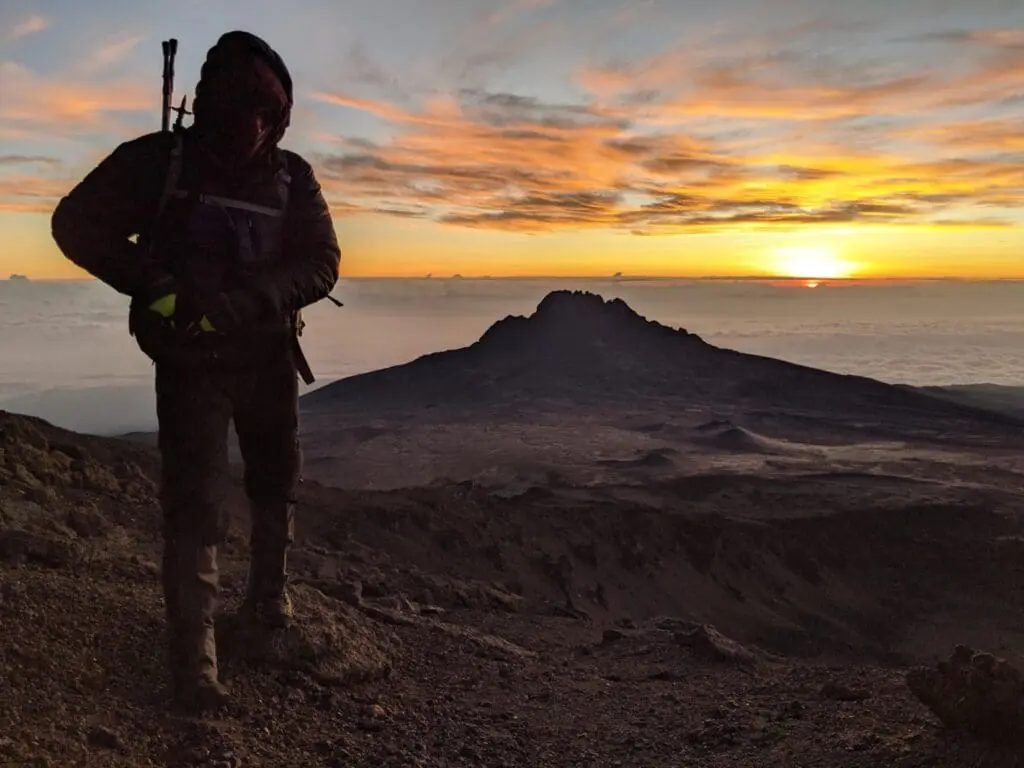
That said, there are a few points of interest on the Kilimanjaro hike that you should know about before setting off. They’re the key markers, the camps, the landmarks, and the geological features that you’ll meet along the way as you climb Mount Kilimanjaro:
10. Preparation and training
Training for climbing Kilimanjaro is no easy task. The best prep for hiking Kilimanjaro is hiking itself. If you haven’t already, get walking. Try to clock up sessions of four to six hours on comparably rough highland trails close to where you live. Better yet, do that wearing the very same boots you’re taking to Africa (see below) and carrying a full day pack on your back.
On top of that, road running, trail running, and weight training can all work wonders for training to climb Kili. Climbing Kilimanjaro demands a decent level of all-round fitness. That’s why it’s a good idea to take a holistic approach while training to climb Mt. Kilimanjaro and up your trekking game across the board – in cardio, strength, and stamina.

What gear do I need to climb Mount Kilimanjaro?
There’s two pieces of good news when it comes to packing to climb Mount Kilimanjaro. One: This isn’t a technical climb, so you don’t need any fangled harnesses or fancy carabiners. Two: The bulk of your pack and gear – including all your food, your sleeping setup, and cooking utensils – will be transported by your team (hence why it’s not unusual to have three porters to every one trekker!).
Your responsibility will be to prepare and pack for long-distance trekking while climbing Kilimanjaro that can last upwards of seven days and involve very unpredictable weather conditions. The best time to climb Kilimanjaro is July to October when the weather is milder, however, Kilimanjaro can summon all four seasons in just as many hours. Snowstorms, torrential rains, sub-zero temperatures, soaring tropical humidity – you can have the lot in a single trekking session. That means layers are key and waterproofs are necessary as you climb Kilimanjaro.
Always pack thermals. If you don’t use them in the heat of the Tanzania day, then you almost certainly will at night when the mercury can plummet below nothing without warning. This is another reason why early fall is the best time to climb Kilimanjaro when the weather is milder. Strong hiking sunscreen is a must as you climb Kili in the open sun. Oh, and be sure to pick a pair of boots that you know are comfy. New boots that aren’t worn in already aren’t a great idea because there’s no way to swap them out once you’re up on the saddle!
Altitude considerations for climbing Kilimanjaro
There are many things to consider when hiking at high altitudes. The altitude adjustment as you climb Mount Kilimanjaro is surely the number-one enemy of climbers looking to hike Kili. But, as one of the great Seven Summits, no one said it would be easy, right? Thing is, Kilimanjaro has an added twist: It’s prominence. Whereas you can start the push for Everest at a basecamp more than 16,400 feet (5,000 meters) up, the Machame Gate is a mere 5,900 feet (1,800 meters) above sea level.
That has ramifications as you climb Mount Kilimanjaro. First, it means you have further to climb on this trek than you would between basecamp and summit on even the highest peak on the planet – it’s 11,433 feet (3,485 meters) from Everest Base Camp to Everest’s top but over 13,400 feet (4,084 meters) from the Machame trailhead to Uhuru Peak on Kilimanjaro!
Second, and most importantly, it means that you don’t have the pre-trekking to help you acclimatize. Here, you’re instantly dropped onto a path from relatively low altitudes and quickly gain as you climb Kilimanjaro.

Anyone who knows anything about Acute Mountain Sickness (AMS) will tell you that it’s not good. Not good at all. However, there are ways to deal with it as you climb Kilimanjaro. In fact, one of the reasons that the Machame Route is now so popular is because it works in two or three nights of sleeping low and trekking high, which is perfect for acclimatizing before the summit push. The result? An overall higher success rate and happier trekkers to boot.
You can also work in treks before you hike Kilimanjaro proper. Mount Meru is a smaller option that’s close by and doable in three or four days and a great way to prepare to climb Mount Kilimanjaro. Climbing Kilimanjaro is no easy task, and you are sure to learn a thing or two along the way.
It’s important to be aware that you’ll be trekking for extended periods above altitudes that are considered safe for humans as you climb Kilimanjaro. Estimations are that around 70% of climbers hiking Kilimanjaro suffer at least some symptoms of AMS. They could be anything from light fatigue to severe headaches and vomiting. Always communicate any level of symptoms to your guides and be ready to descend to lower altitudes if things get too bad as you climb Mount Kilimanjaro. Safety is our number one priority, so make sure you’re aware of the many important reasons to turn back during an adventure.
Mount Kilimanjaro permits
It’s been almost 30 years since the Tanzanian government imposed the requirement that all trekkers who wish to climb Kilimanjaro engage a licensed guide. There’s no going at this one alone, folks. You have to get help from a qualified company that specializes in trekking in the region, though those are certainly not all created equal, but that’s another story.
In addition, everyone entering the Kilimanjaro National Park is liable to pay certain fees. These actually make up a hefty chunk of the cost of most trekking packages, sometimes accounting for as much as 70% of the total cost to climb Kilimanjaro. They include a conservation fee of around $70 per day, a camping levy of $50 per trekker, per night, and $2 per porter and guide, per day. As you can imagine that all adds up over a seven-day expedition to climb Kilimanjaro– you’re looking at around $955 in fees for the normal Machame Route. Thankfully, these are usually included in quoted costs to climb Kilimanjaro as part of your travel package and are paid by the tour organizer beforehand.
All prices listed in US Dollars.

Passports and visas to visit Tanzania
There’s a little visa admin to go through either before you touch down in Kilimanjaro or as you pass through the airport on the way to Moshi, Tanzania. That is, unless you’re from one of the 70 or so countries that get visa-free access to Tanzania. Sadly, the USA and the UK aren’t included in said list, though it is possible to get a 90-day visa on arrival. It costs $50 for non-US citizens and $100 for US citizens and must be purchased in dollars.
All prices listed in US Dollars.
You can now also pre-authorize your visa to reduce waits at the airport (and there can be waits!) by applying for an eVisa on the official Tanzania immigration portal online. These expenses are important to factor in when considering the total cost to climb Mount Kilimanjaro. If all this sounds overwhelming, don’t worry! The Explorer’s Passage is always here to work with you and your preferences to craft a trip that fits your needs.
11. Other adventures near Mount Kilimanjaro
The desire to stand at the very top of Africa draws something like 50,000 trekkers to Tanzania to climb Mount Kilimanjaro every year. But that’s actually only a fraction of the total number of people who come to the beautiful country of Tanzania. Yep, the surrounding Kilimanjaro National Park can pull in 5,000 extra day visitors itself, and that’s not even mentioning the safari meccas, lakes, waterfalls, and other natural jewels that abound in the greater region.
Here’s a look at just a few of the most enticing adventures to be had near Mount Kilimanjaro:
Cultural activities in the Mount Kilimanjaro region
The Mount Kilimanjaro region is a unique melting pot of East African peoples and cultures. It’s a land where the Maasai merge with the Chagga folk, where the Pare peoples of the highlands mingle with descendants of Indian émigrés. If that sounds like a great place for cultural excursions, then that’s because it is. Check out:
Safari options in Tanzania
Got some time left after your seven-day Kilimanjaro climb? There’s no better way to fill it than with a Tanzanian safari. In fact, the region around Moshi is considered one of the finest safari destinations on the planet. It’s got a string of five reserves (the Mount Kilimanjaro National Park among them) that are together referred to as the Northern Circuit, offering glimpses of diverse habitats and the fabled Big Five game.


This trip guide is just a taste of what you’ll experience on a remarkable trek up Mount Kilimanjaro. For more things you should know before climbing Mt. Kilimanjaro, check out the curated list of educational blog posts located on our website.
Better yet, if you have more questions on hiking Kilimanjaro or need help planning your trip to Tanzania, let’s connect! Our knowledgeable Adventure Consultants would love to hear from you so contact us and let us show you what’s possible.
Why travel with The Explorer’s Passage?
We pride ourselves on delivering extraordinary tours based on travelers’ needs and are humbled by our guests’ testimonials. In fact, our dedication has earned us a 5-star rating on Tripadvisor, and awards by Travel+Leisure Magazine and Newsweek. Check us out and discover why so many travelers worldwide choose us. My team and I would love for you to join us on the trek to Mount Kilimanjaro or any of our many other adventure trips!
Cheers,
Jeff
Jeff Bonaldi
Founder & CEO
The Explorer’s Passage
About Jeff Bonaldi
Jeff Bonaldi is the Founder and CEO of The Explorer’s Passage, a premier adventure travel company. His mission is to provide travelers with the opportunity to transform their lives and the planet through the power of adventure.
Learn more about Jeff’s story and his company HERE.
Share this amazing location!

